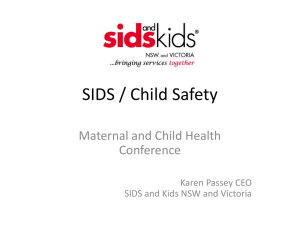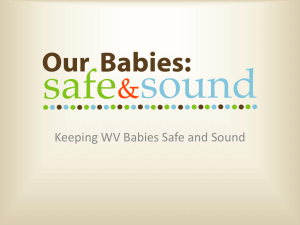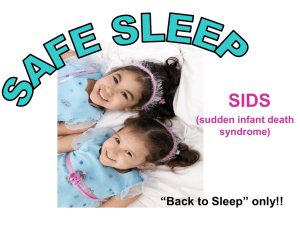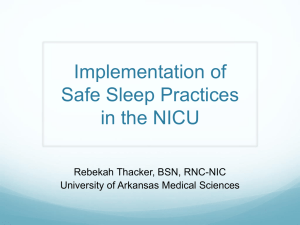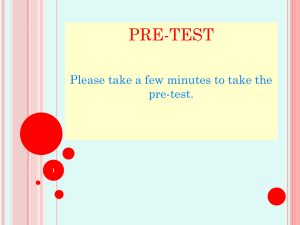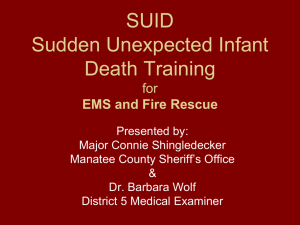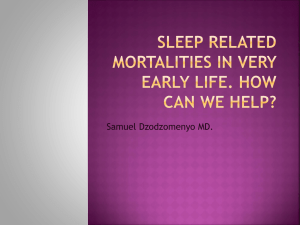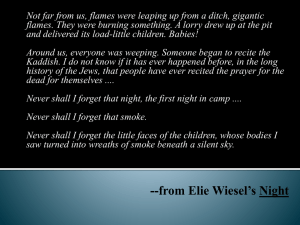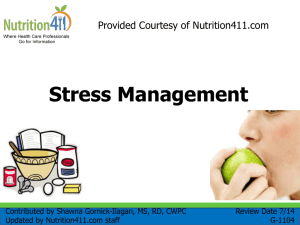Safe Sleep PowerPoint Presentation
advertisement
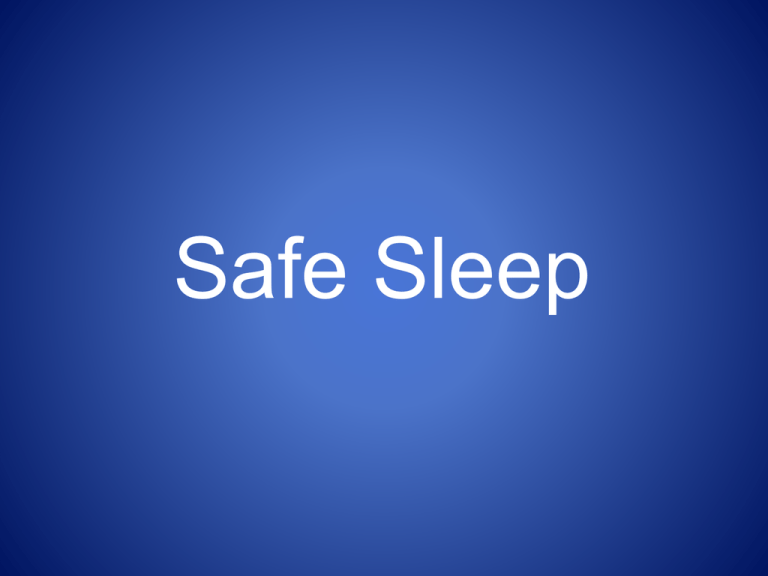
Safe Sleep Objectives • Increase understanding of sleep-related deaths • Describe the Triple Risk Model • Identify modifiable/non-modifiable risks • Understand meaning of “Alone, Back, Crib” • Motivate integration of Safe Sleep into nursing practice SIDS Sudden Infant Death Syndrome SUID Sudden Unexpected Infant Death ASSB Accidental suffocation and strangulation in bed All are terms to describe sleep-related deaths of a baby younger than 1 yr of age Chances of these happening go down with a few simple changes in how babies sleep 1983-1992 5,000-6,000 SIDS deaths/yr 1992 American Academy of Pediatrics recommended infants <1 yr be placed to sleep on back or side 1996 Recommendation changed to sleep only on back Since babies have been put to sleep on their backs SIDS deaths have ’d by 50% However putting babies on their backs has not been enough to prevent sleep-related deaths There are other risks Some are modifiable Some are non-modifiable #1 #2 #3 #1 Vulnerable Infant Some babies are more likely to die from SIDS because of abnormal control of: - Blood pressure - Heart rate - Respiration - Chemoreception - Upper airway reflexes - Thermoregulation Non-modifiable Risk Factor #1 Vulnerable Infant Prematurity and Low birth weight SIDS risk: with birth wt and gestational age Non-modifiable Risk Factors #1 Vulnerable Infant Race African American infants >2x more SIDS than Caucasian infants American Indian infants >3x more SIDS than Caucasian infants Non-modifiable Risk Factor #2 Critical Developmental Period Rapid growth and development of brain in 1st year of life Autonomic function reorganization Learned protective behaviors Non-modifiable Risk Factor #3 External Stressor/s We can’t control whether a baby is a “vulnerable infant” or whether a baby is in a “critical developmental period” However We CAN control external stressors ALL are modifiable #3 External Stressor/s Second-hand Smoke #3 External Stressor/s Follow ABC’s of Safe Sleep Alone Back Crib Alone The competition we’re up against This is what we’re asking parents to do NO Pillows Loose blankets Stuffed toys Bumper pads This is no longer acceptable A blanket can become a suffocation hazard If you need to use a blanket use it “Feet to Foot” Like this Not this Yes! to Blanket Sleepers After 37 weeks and prior to discharge swaddling with a blanket during sleep is not recommended Swaddling 34-37 weeks gestation: - Swaddle with one blanket below the arms - If second blanket is needed for thermal support, place it no higher than baby’s chest and tuck it around crib mattress What about the baby with poor upper body tone? May need to be swaddled from mid-arms down to help bring arms to midline Good Rules of Thumb Room temperature should be comfortable for a lightly clothed adult ~ 72 degrees Dress baby in no more than one layer than you are dressed A well-fitting hat is OK for thermoregulation for preterms This Not this Remove for sleep at 37 wks or prior to discharge This might look cozy But it is DANGEROUS! Danger of entrapment and suffocation Extremely high risk of death on couches and armchairs Parents should not feed their baby on a couch or armchair if there is a chance of falling asleep Baby should sleep alone Baby may be in parent’s bed for feeding or comforting but should be returned to his/her own bed when parent is ready to return to sleep Billboards in Milwaukee, WI “Your baby sleeping with you can be just as dangerous” Alone but IN room with mother is best Back Every baby should be placed “back to sleep” Every sleep by Every caregiver for the 1st year of life But babies sleep better on their stomachs! Yes, they do But that is why they are more likely to die! Prone position can result in: ’d re-breathing of carbon dioxide ’d stimulation of laryngeal receptors causing apnea ’d efficient loss of heat ’d arousal What about spitting up? In prone position milk may pool in the hypopharynx *Less likely to choke in supine position* Guidelines for premature infants born at < 34 weeks who are medically stable By 32-34 weeks gestation: Begin transition to supine sleeping in a flat bed without nests, pillows or developmental supports By 34 weeks gestation or when successfully weaned to an open crib: Infant should sleep supine, without nests or developmental supports and with head of bed flat What about a baby with reflux? head of bed does NOT reflux head of bed may result in baby sliding and compromising airway However: - Do feed in an position - Do hold in position or keep head of bed for 30 min after feeds Exceptions to this? • Babies with life-threatening airway issues (e.g. laryngeal cleft…) • Babies with impaired airway protective mechanisms (e.g. paralyzed vocal cord…) • Babies with aspiration related to reflux • Babies awaiting anti-reflux surgery What about positioning devices? None have been approved But what about positioning devices for our < 32 wk preemies and sick babies? Yes! We can use them! Safe Sleep guidelines are for medically stable babies What about delayed upper body development? Upper body strength will be met with a total Tummy Time of at least 1hr/day Tummy Time when awake and alert What about flat spots on a baby’s head? • Tummy Time helps to reduce flat spots • Changing the direction a baby sleeps in reduces flat spots Flat spots usually resolve in a few months after a baby learns to sit up What about a bald spot? Consider a bald spot on the back of a baby’s head a sign of a healthy baby! Once an infant can roll from supine to prone and from prone to supine, infant can be allowed to remain in the sleep position that he or she assumes Crib Firm mattress covered by a fitted sheet Crib Pac and Play What about swings, bouncy seats…? Should not be used for sleeping If an infant falls asleep in one, he or she should be removed and placed in their bed soon as it is practical Exceptions to Safe Sleep: ** Must have a physician or NNP order documenting exception and indication for exception Example: may have head of bed up 30◦ - infant with aspiration noted on milk scan Example: may sleep in swing - infant with Neonatal Abstinence Syndrome (NAS) Prior to discharge: - Attempt should be made to assess infant’s ability to eliminate exception(s) and follow all Safe Sleep environment recommendations - If infant continues to need any exception(s) to Safe Sleep recommendations these should be fully discussed and planned for at time of discharge Are there other things that might protect babies from sleep-related death? Protective effect of a dry pacifier This Not this Not these either Some guidelines for pacifiers: - Offer pacifier, but don’t force it - If pacifier falls out while baby is asleep do not replace it - Wait until breastfeeding is well established before offering pacifier Two more things that protect babies from SIDS Breastfeeding Immunizations Breastfed babies have fewer infections Some babies who died of SIDS had recent infections before they died Immunizations Immunizations cut a baby’s risk of SIDS almost in half So what can we do? Safe Sleep needs to start with us! We need to teach parents Safe Sleep We need to model Safe Sleep Transition process in the NICU Prone Supine Supported Unsupported Positioning “ILL” status “HEALTHY” status Summary • Triple Risk Model - Vulnerable infant - Critical Developmental Period - Outside stressor/s • Alone, Back, Crib • Use of dry pacifier, breastfeeding, immunizations • Role modeling for families Safe Sleep Safe Sleep STANDARD OF CARE References American Academy of Pediatrics, Task Force on Infant Sleep Position and Sudden Infant Death Syndrome. Changing concepts of sudden infant death syndrome: implications for infant sleeping environment and sleep position. Pediatrics. 2000;105:650–656 http://pediatrics.aappublications.org/content/105/3/6 50.full.html References Eunice Kennedy Shriver National Institute of Child Health and Human Development, NIH, DHHS. (2007). Curriculum for Nurses: Continuing Education Program on SIDS Risk Reduction (06-6005). Washington, DC: U.S. Government Printing Office http://www.nichd.nih.gov/publications/pubs_details. cfm?from=&pubs_id=5685 References Filiano, JJ, Kinney, HC. A perspective on neuropathologic findings in victims of the sudden infant death syndrome: the triple risk model. Biolol Neonate. 1994;65(3-4):194-197. Ibarra, B. Family Teaching Toolbox: A Parent’s Guide To A Safe Sleep Environment. Advances in Neonatal Care. 2011; 11 (1), p 27-28 References Moon, RY, Fu, L. (2012). Sudden infant death syndrome: an update. Pediatrics in Review. DOI: 10.1542/pir.33-7-314 Task Force on Sudden Infant Death Syndrome. SIDS and other sleep- related infant deaths: Expansion of recommendations for a safe infant sleeping environment. Pediatrics. 2001;128 (5) e1341-e1367. http://pediatrics.aappublications.org/content/128/5/e13 41.full
